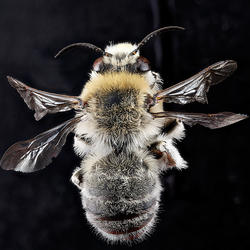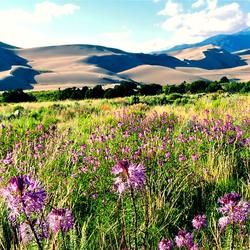This bee is in your garden! Have you seen it? Collected on the Tomatoes in Francisco Posada's garden in Laurel, Maryland
Do native bees occur on every continent on the planet?
Native bees occur on every continent except Antarctica. Wherever there are insect-pollinated flowering plants—be it in forest, farms, cities, and wildlands—there are bees. And just because you don’t see obvious blooming plants, that does not mean that there are no bees around. Look down! Those tiny flowers that you see on some plants are also supporting billions of equally tiny bees.
Learn more:
Related
Why are bats important?
Why are pollinating bats, birds, bees, butterflies, and other animals important?
What is the role of native bees in the United States?
How many species of native bees are in the United States?
Does the loss of plant diversity affect the health of native bees?
Do bees feed on both nectar and pollen?
Are honey bees native to North America?
This bee is in your garden! Have you seen it? Collected on the Tomatoes in Francisco Posada's garden in Laurel, Maryland
This bee is in your garden! Have you seen it? Collected on the Tomatoes in Francisco Posada's in Laurel, Maryland
This bee is in your garden! Have you seen it? Collected on the Tomatoes in Francisco Posada's in Laurel, Maryland

Anthophora bomboides. Fuzzy . Faking the bumble bee look to fool birds into thinking they can sting like a bumble bee. Here is one from San Juan Island in Washington State. This species occurs throughout the continent....but....its look differs across that huge geographic range. Are they more than one species or not? Does anyone care? You?
Anthophora bomboides. Fuzzy . Faking the bumble bee look to fool birds into thinking they can sting like a bumble bee. Here is one from San Juan Island in Washington State. This species occurs throughout the continent....but....its look differs across that huge geographic range. Are they more than one species or not? Does anyone care? You?
Anthophora occidentalis, male, Badlands National Park, June 2012
Anthophora occidentalis, male, Badlands National Park, June 2012
Fossil Butte National Monument, WyomingNote that friends at National Wildlife Federation have dubbed this species the Billy Idol Bee. Since it has no common name I hear-by declare this species' common name to be the Billy Idol MelectaNote, however, that all the bees in the genus Melecta are nest parasites
Fossil Butte National Monument, WyomingNote that friends at National Wildlife Federation have dubbed this species the Billy Idol Bee. Since it has no common name I hear-by declare this species' common name to be the Billy Idol MelectaNote, however, that all the bees in the genus Melecta are nest parasites
Morris Arboretum, Philadelphia Pennsylvania, covered in pollen from an unknown plant
Morris Arboretum, Philadelphia Pennsylvania, covered in pollen from an unknown plant
The USGS Ecosystems Mission Area brings you Outstanding in the Field, a series of stories about our science, our adventures, and our efforts to better understand our fish and wildlife and the ecosystems that support them.
 Untapped Capacity: Our 4,000 Species of Native Bees
Untapped Capacity: Our 4,000 Species of Native Bees
So many unknowns and so many potentials.
So many unknowns and so many potentials.
It's Pollinator Week, and we're talking to USGS scientist Sam Droege about the tremendous importance of native bees and pollinators in general, and how you can lend a hand to these tiny titans.
Pollinator conservation and climate science at the U.S. Geological Survey
The bee lab
Flowering plants preferred by bees of the Prairie Pothole Region
Forage and habitat for pollinators in the northern Great Plains—Implications for U.S. Department of Agriculture conservation programs
Identification of bees in southwest Idaho—A guide for beginners
National protocol framework for the inventory and monitoring of bees
Related
Why are bats important?
Why are pollinating bats, birds, bees, butterflies, and other animals important?
What is the role of native bees in the United States?
How many species of native bees are in the United States?
Does the loss of plant diversity affect the health of native bees?
Do bees feed on both nectar and pollen?
Are honey bees native to North America?
This bee is in your garden! Have you seen it? Collected on the Tomatoes in Francisco Posada's garden in Laurel, Maryland
This bee is in your garden! Have you seen it? Collected on the Tomatoes in Francisco Posada's garden in Laurel, Maryland
This bee is in your garden! Have you seen it? Collected on the Tomatoes in Francisco Posada's in Laurel, Maryland
This bee is in your garden! Have you seen it? Collected on the Tomatoes in Francisco Posada's in Laurel, Maryland

Anthophora bomboides. Fuzzy . Faking the bumble bee look to fool birds into thinking they can sting like a bumble bee. Here is one from San Juan Island in Washington State. This species occurs throughout the continent....but....its look differs across that huge geographic range. Are they more than one species or not? Does anyone care? You?
Anthophora bomboides. Fuzzy . Faking the bumble bee look to fool birds into thinking they can sting like a bumble bee. Here is one from San Juan Island in Washington State. This species occurs throughout the continent....but....its look differs across that huge geographic range. Are they more than one species or not? Does anyone care? You?
Anthophora occidentalis, male, Badlands National Park, June 2012
Anthophora occidentalis, male, Badlands National Park, June 2012
Fossil Butte National Monument, WyomingNote that friends at National Wildlife Federation have dubbed this species the Billy Idol Bee. Since it has no common name I hear-by declare this species' common name to be the Billy Idol MelectaNote, however, that all the bees in the genus Melecta are nest parasites
Fossil Butte National Monument, WyomingNote that friends at National Wildlife Federation have dubbed this species the Billy Idol Bee. Since it has no common name I hear-by declare this species' common name to be the Billy Idol MelectaNote, however, that all the bees in the genus Melecta are nest parasites
Morris Arboretum, Philadelphia Pennsylvania, covered in pollen from an unknown plant
Morris Arboretum, Philadelphia Pennsylvania, covered in pollen from an unknown plant
The USGS Ecosystems Mission Area brings you Outstanding in the Field, a series of stories about our science, our adventures, and our efforts to better understand our fish and wildlife and the ecosystems that support them.
 Untapped Capacity: Our 4,000 Species of Native Bees
Untapped Capacity: Our 4,000 Species of Native Bees
So many unknowns and so many potentials.
So many unknowns and so many potentials.
It's Pollinator Week, and we're talking to USGS scientist Sam Droege about the tremendous importance of native bees and pollinators in general, and how you can lend a hand to these tiny titans.















